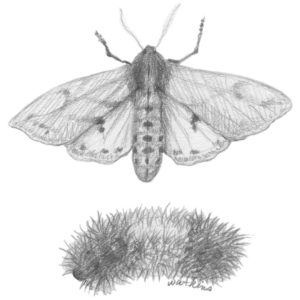November, Winter Is Coming
By Leslie Watkins

Woolly bear, © Leslie Watkins 2018
Along with signs like the early migration of birds and butterflies, pigs collecting sticks and an abundance of acorns, banded woolly bear caterpillars are thought to forecast a long, cold winter when they sport a narrow band of orange and are especially fuzzy. Woolly bears hatch in the fall and eat various leaves. They produce a kind of anti-freeze and during hibernation can survive temperatures of –90 degrees Fahrenheit. Woolly bears become mobile again in spring when it warms back up to 50 degrees. After eating their fill of dandelion, plantain and other leaves they spin cocoons using their own fur and eventually pupate into the pretty, black-spotted, orange Isabella tiger moths (Pyrrharctia Isabella).
In preparing for winter, sometimes less is more. Allowing the fruit and stalks of many plants to persist in our garden benefits birds and other wildlife. Undisturbed leaf litter is good composting mulch for plants; it sustains and protects many creatures and organisms. Caterpillars hatch out of eggs attached to leaves that the larvae then eat. The leaves fall and caterpillars roll up in them to overwinter. Among the more spectacular caterpillars are the larvae of the giant leopard moth (Hypercompe scribonia). They are black, spiky and big, growing up to 3 inches long.
Dead, broken tree trunks and limbs left on the tree and on the ground provide needed shelter for birds including woodpeckers, mammals, amphibians, various invertebrates and overwintering insects. Many of these insects help keep our gardens and wild places in balance by providing protein-rich food for wildlife. The dried seed heads of Joe Pye weed, goldenrod, echinacea and sunflowers are raised above snow levels, providing birds an excellent food source through the winter while providing us winter interest. On the other hand, over-mulching perennial beds can give pernicious voles an invitation to take up residence there. They seek the cover mulch gives them from snow and predators, allowing them to feed on roots and bark unseen. It’s best to wait until after freezing to mulch around trees and shrubs to prevent vole damage.
We become more aware of the the effect nature has on us during transitional seasons like spring and fall. When we notice snow melting, green shoots emerging and buds swelling in spring, we’re glad to think of flowers, sunny warm days and good times to come. In autumn we bustle about, busy as squirrels preparing for the icy grip of winter. Plants, trees and animals know instinctively what they must do. Lower temperatures and shorter days trigger actions they must follow to survive. We also make winter preparations, like having the chimney cleaned, getting firewood ready, finding the snow shovel and getting out warm clothes. As we accomplish these tasks we might also consider planning for the future.
In looking back, we see ahead. We are not as subject to circumstance and environment as animals are. With foresight, good decision making and goal defining, we can chart the course of our lives. Winter is a great season to contemplate our failures and recognize our strengths. Knowing where we intend to go and how to best get there are powerful tools for success. Meditation, visualization, and journaling help us to clarify and focus. When we take the long view we can reverse engineer the necessary steps to help keep us on track in our careers, our relationships and in realizing our ambitions. We gain knowledge through close observation of both our inner and outer landscapes.
November Checklist
Clean out gutters.
Put out snowplow reflectors.
Wrap trunks of young trees.
Bring in ceramic containers.
Put up clean bird feeders.
Clean out nesting boxes.
Build a brush pile.
Turn off water spigots.
Remove asparagus, squash and brassica debris.
Prune viburnums to remove viiburnum leaf beetle eggs.
